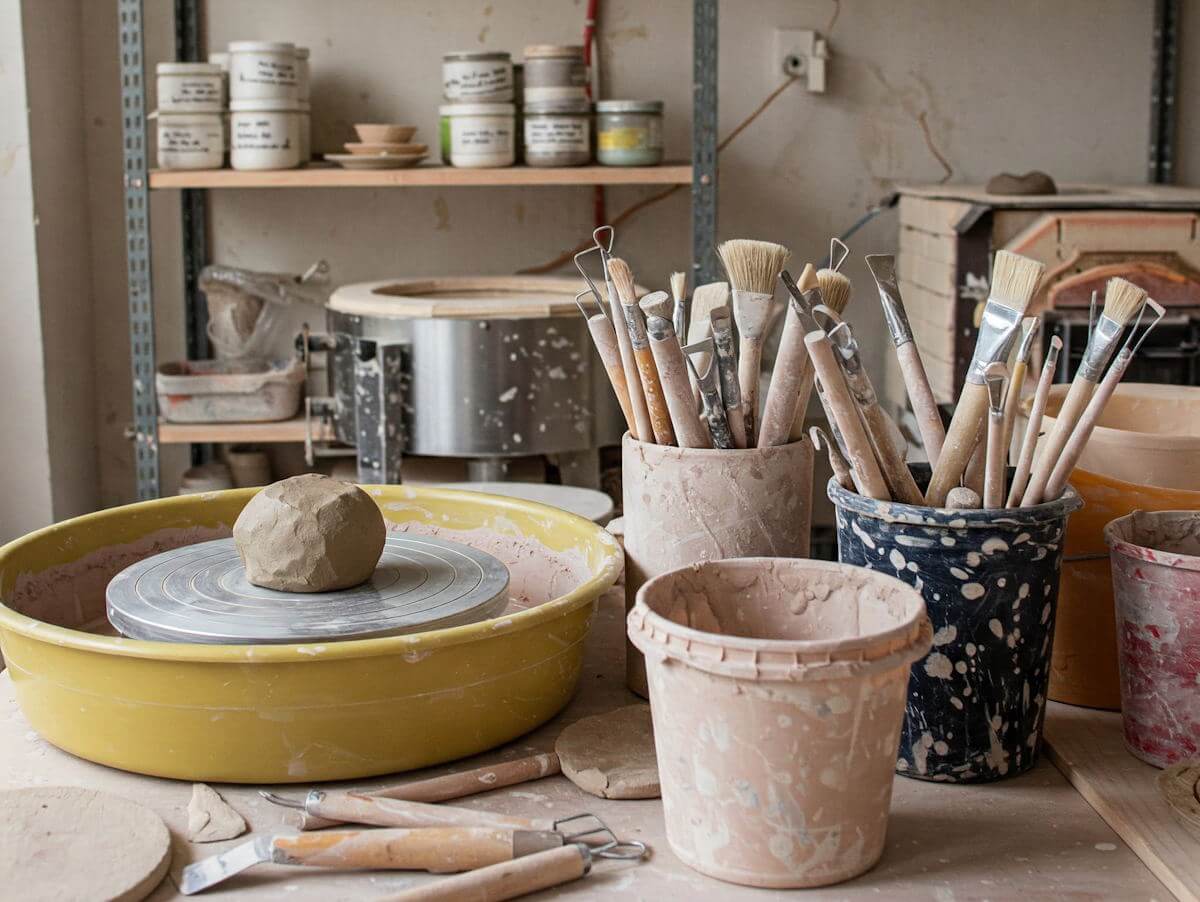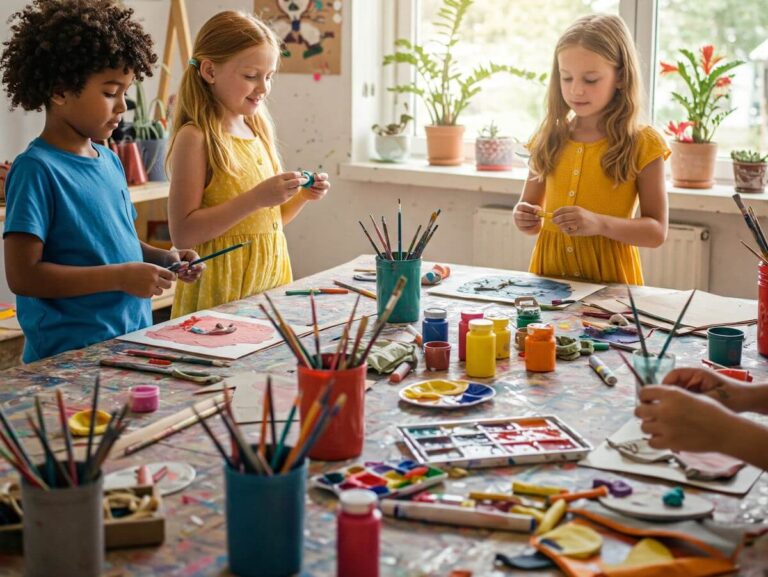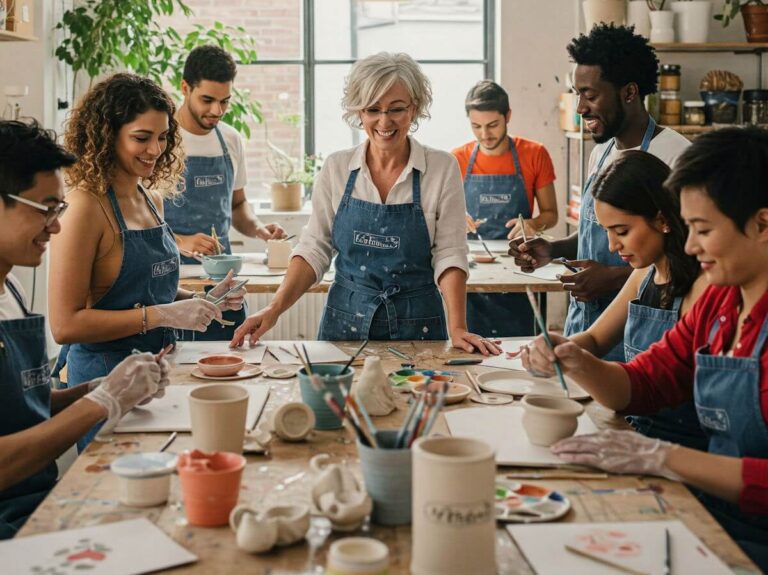Pottery workshops serve as a dynamic environment where individuals can explore and cultivate their artistic talents in the medium of clay. These workshops cater to a diverse audience, providing a welcoming space for both beginners eager to learn and seasoned potters looking to refine their skills. The essence of pottery lies in its ability to transform raw clay into functional and decorative pieces, offering a tangible form of creative expression that resonates with artists of all levels.
At a pottery workshop, participants engage in the hands-on process of shaping clay, which not only fosters creativity but also enhances fine motor skills. The experience often includes learning various techniques such as throwing on a potter’s wheel, hand-building, and glazing, which are fundamental to the craft of pottery. For beginners, these sessions provide a structured introduction to the tools and materials required for successful pottery-making, while experienced potters can take the opportunity to experiment with new styles and methods.
One of the standout benefits of participating in pottery workshops is the sense of community they create. Engaging with fellow pottery enthusiasts fosters collaboration and inspiration, as artists share ideas and techniques in a supportive environment. This camaraderie can be particularly beneficial for beginners, offering them a network of peers who can support their artistic journey. Additionally, the collaborative nature of pottery workshops cultivates an atmosphere where participants can receive constructive feedback, which is invaluable for personal growth in the art form.
Essential Tools for Pottery
Engaging in pottery requires a variety of essential tools that streamline the creative process and enhance the quality of work. One of the most fundamental tools in any pottery workshop is the pottery wheel. This spinning device allows potters to shape clay into symmetrical forms with precision and speed. Whether you are creating bowls, vases, or other ceramic objects, the pottery wheel is vital for achieving the desired aesthetics and functionality in your work.
In addition to the wheel, hand-building tools play a crucial role, especially for those who prefer methods such as coil or slab building. These tools include rib tools, pin tools, and wire cutters. Rib tools help in smoothing and shaping your clay, while pin tools are great for detailing and precision cuts. Wire cutters allow for easy removal of clay from any surface, facilitating clean edges and finishes.
Trimming tools like loop tools and trimming knives are equally essential during the pottery-making process. After the initial shaping, trimming helps refine the piece by removing excess clay and creating uniform thickness. Loop tools are particularly useful for removing clay while creating curves and contours that add character and touch to your final design.
Moreover, additional hand tools, such as sponges and wooden modeling tools, contribute significantly to the pottery process. Sponges assist in adding moisture to clay, which is vital for workable consistency, while wooden modeling tools can help shape and texture the surfaces of ceramics as well. Each tool in a pottery workshop serves a distinct purpose, coming together to bolster creativity and improve efficiency in the crafting of art from clay.
Overview of Pottery Materials
The world of pottery is richly varied, and the materials utilized play a crucial role in shaping the outcome of each piece. Among the most common materials is clay, which can be categorized into several types, each with distinct properties. The primary types of clay include earthenware, stoneware, and porcelain, each offering unique characteristics suitable for different pottery techniques.
Earthenware is one of the oldest forms of pottery. It is characterized by its porous nature, which makes it ideal for applications where breathability is a feature. Earthenware is easily manipulated and can be fired at lower temperatures, making it accessible for beginners while allowing for vibrant glazing options. However, it is not as durable as other clays, often leading to chipping or breaking under stress.
In contrast, stoneware is more robust, made from a clay that matures at higher firing temperatures. This material is known for its strength and impermeability when properly vitrified, allowing for functional ware such as dinner sets and bakeware. Stoneware glazes often present a more rustic appearance, enhancing the overall aesthetic of the pieces.
Porcelain, on the other hand, stands out for its delicate, translucent quality, achieved through kaolin and being fired at exceptionally high temperatures. Its non-porous nature and fine texture enable intricate designs and fine details, making it a favorite in both art ceramics and high-quality tableware. The professional handling of porcelain requires specific techniques, making it less suitable for beginners.
Additionally, various other materials contribute to the pottery-making process, such as glazes and underglazes. Glazes serve to create unique surface finishes and colors, while underglazes provide a colored base that can be decorated upon. Additives like grog, which consists of pre-fired clay, can alter the texture and strength of the clay body, further expanding the creative possibilities in pottery.
Choosing the Right Clay
Selecting the appropriate clay is a fundamental step for any potter embarking on their creative journey. The variety of clays available presents both opportunities and challenges, as different types cater to distinct needs and artistic visions. Among the essential factors to consider when choosing clay are firing temperature, color, texture, and workability.
Firing temperature is perhaps the most critical aspect, as it determines the type of kiln and firing process required. Generally, clays are categorized into two main groups: earthenware and stoneware. Earthenware clays typically fire at lower temperatures, making them suitable for beginners, while stoneware clays can withstand higher temperatures and are ideal for creating durable, functional pottery. Understanding these distinctions ensures that potters select a clay that aligns with their firing capabilities and desired outcomes.
Color is another vital consideration when selecting clay. Clays can vary widely in hue, from warm reds and browns to cooler grays and whites. The clay’s color will influence the final appearance of the ceramic piece, especially once glazes are applied. Potters should experiment with different clay colors to find a match that complements their artistic intent. Additionally, some clays can exhibit unique textures and finishes when fired, adding another layer of depth to the finished work.
Workability plays a crucial role in the creative process as well. Some clays are more forgiving and easier to manipulate, making them suitable for beginners or those engaged in intricate detailing. On the other hand, clays with a tighter texture may be more challenging but can yield stunning results for experienced potters. Ultimately, the choice of clay should reflect the potter’s skill level, project requirements, and personal preferences. By carefully evaluating these factors, potters can select the ideal clay and set the foundation for successful ceramic creations.
Glazes and Finishes: Adding Color and Texture
Glazes and finishes are crucial elements in the pottery-making process, transforming the raw clay into vibrant, visually appealing works of art. A variety of glazes are available, each offering unique aesthetic qualities and functional characteristics. Among the most common types are transparent, opaque, and textured glazes. Transparent glazes allow the underlying clay body and any decorative underglazes or textures to show through, creating depth and luminosity. Opaque glazes, on the other hand, conceal the clay beneath, delivering a consistent color that can significantly alter the piece’s overall appearance.
Textured glazes provide another dimension to pottery, introducing patterns and visual interest that can enhance the tactile experience of the piece. These glazes may contain additives such as silica or sand, which create a rough surface that contrasts with smooth areas. The interplay between gloss and texture can result in captivating designs, opening a realm of creative possibilities for potters who wish to experiment with various effects.
Applying glaze properly is essential for achieving the desired finish. Techniques may include dipping, pouring, brushing, or spraying, each offering distinct application dynamics. Dipping and pouring enable an even coat, while brushing allows for more control in detailing. Spraying can create an airbrushed look, suitable for both subtle gradations and bold color applications. It is also important to consider the firing process, as the type of clay body and glaze combination will dictate firing temperatures and methods, which will, in turn, affect the final outcome. Kiln settings, including temperature control and atmosphere, also play an integral role in how the glaze reacts, allowing for a unique transformation of each piece during the firing stage. By understanding these aspects, potters can refine their techniques, resulting in extraordinary, one-of-a-kind creations.
Basic Safety and Maintenance in the Studio
Ensuring safety and maintenance in a pottery workshop is vital for fostering a productive and secure environment, essential for both novice and experienced potters. In any studio, handling materials with care is paramount. Many clays, glazes, and other materials can pose health risks, especially if inhaled or ingested. Potters should familiarize themselves with Material Safety Data Sheets (MSDS) for all substances they work with, as this will provide detailed information on potential hazards, handling instructions, and first-aid measures.
Using appropriate protective gear is also critical. Safety goggles can safeguard against flying debris, while masks can protect the respiratory system from dust and harmful particulates, particularly when mixing dry materials or sanding fired pieces. Additionally, gloves should be worn to prevent skin irritation from certain glazes and clays. To enhance safety, it is advisable to keep a first-aid kit on hand, ensuring that immediate assistance is available in case of minor accidents.
Maintaining a clean studio is integral to ensuring safety. Regularly cleaning work surfaces helps eliminate dust and debris that can cause accidents or respiratory issues. Moreover, promptly cleaning spills not only prevents slips but also removes the risk of contamination of work materials. A well-organized studio, with tools and materials stored correctly, minimizes confusion and accidents during pottery-making sessions.
Furthermore, the upkeep of tools enables potters to work more efficiently. Regular checks for wear and tear on tools can prevent injuries and maintain the quality of work. Potters should also ensure that equipment, such as kilns and wheels, is functioning correctly and receives routine servicing. Implementing these safety practices can significantly enhance the overall experience and productivity within the pottery workshop.
Pottery Techniques to Explore
Pottery workshops are ideal environments for honing various pottery techniques, each offering unique approaches to creating ceramic art. Among the most popular techniques are wheel throwing, hand-building, and slab construction, each requiring different tools and materials tailored to their respective processes.
Wheel throwing is a time-honored technique that uses a pottery wheel to shape the clay. This method allows potters to create uniform and symmetrical pieces, such as bowls and vases. Essential tools for wheel throwing include a pottery wheel, a variety of clay types suitable for wheel throwing, and trimming tools for refining the forms. Beginners should start with mid-range plastic clays to allow for easier manipulation and a smoother learning curve.
Hand-building is a versatile technique that incorporates various methods, such as pinching, coiling, and modeling. This approach is particularly beneficial for potters who enjoy more organic shapes and intricate details. Tools needed for hand-building include simple crafting tools like wooden modeling sticks, rulers for measuring, and finger tools for smoothing and refining surfaces. A good quality earthenware or stoneware clay is ideal for beginners since it is forgiving and easy to work with.
Slab construction involves rolling out flat sheets of clay and assembling them to build structures. This technique is particularly useful for creating tiles, boxes, and complex sculptures. Essential tools include a rolling pin for even slab thickness, a square and knife for cutting, and scoring tools for joining pieces. Potters should also consider using a leather-hard clay to ensure that slabs maintain shape while being manipulated.
Each technique offers distinct challenges and creative opportunities. For those just starting in pottery, exploring these methods can lead to a deeper understanding of the craft and help in developing personal styles.
Setting Up Your Own Pottery Workshop
Establishing a pottery workshop at home or in a community space can be an exciting endeavor, blending creativity with functional artistry. The initial step involves evaluating available space, as a well-organized area is pivotal for efficient work. A dedicated room or corner should ideally accommodate essential equipment while allowing for movement and the necessary firing process.
When outlining your pottery workshop, consider the layout. A spacious workbench for hand-building, throwing, and glazing is vital. Additionally, ensure access to water, as it’s a critical component in the pottery process. A sink or a large basin can streamline the cleanup and preparation phases. Appropriate ventilation is essential, especially when working with glazes and during the firing process. Proper ventilation helps in maintaining a safe environment and allows for the effective dispersal of any potentially harmful fumes.
Essential tools for your pottery workshop include a potter’s wheel, various shaping tools, sponge, and measuring tools such as calipers. A sturdy kiln is also necessary for firing your creations. Consider investing in a quality clay that suits your desired pottery style, whether stoneware, earthenware, or porcelain. Each type of clay has unique characteristics and firing requirements, which can affect the final product.
To foster an inspiring atmosphere, decorate your workshop with art pieces that motivate you. An organized workspace can enhance creativity; therefore, implementing storage solutions for tools, clay, and finished pieces is beneficial. Labeling containers can further streamline the workflow, saving time during busy sessions. Ultimately, setting up your pottery workshop should reflect your personal style while dedicating space for the tools and materials essential for successful pottery-making.
Conclusion and Encouragement for New Potters
As we draw this discussion to a close, it is important to reiterate the significance of having the right tools and materials in your pottery journey. Whether you are sculpting your first piece or refining your skills, investing in quality pottery equipment is essential. Not only do the appropriate tools enhance your creative process, but they also enable you to produce work that reflects your unique style and vision. From basic essentials like clay and a wheel to specialized items such as glazes and carving tools, each element plays a role in bringing your artistic ideas to life.
For those who are venturing into the world of pottery for the first time, the journey can indeed feel intimidating. However, it is equally filled with joy and fulfillment. Engaging in workshops not only helps you master the craft, but also allows you to connect with a community of fellow enthusiasts. This supportive environment can be invaluable, offering encouragement and sharing tips that can greatly enhance your learning experience. Moreover, the friendships formed during these workshops create a sense of belonging and motivation to continue exploring your creativity.
Therefore, I urge all aspiring potters to take that first step. Do not hesitate to explore your artistic abilities, and remember that every piece you create is a step towards your growth as an artist. The world of pottery is vibrant and welcoming, filled with individuals who share your passion and are eager to support you. Embrace the process, celebrate your progress, and let your creativity shine. Your journey into the realm of pottery is just beginning, and it holds endless possibilities waiting to be discovered.




